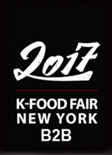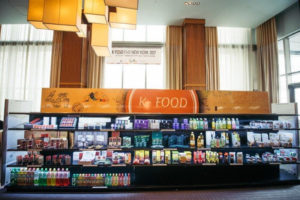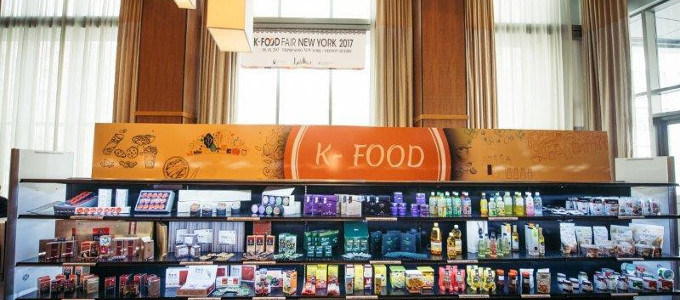The Forecast for the Future of Korean Food & Beverages in the US Emerges at aT Center’s Korean Food Fair
New Products, Insights, Market Opportunities and the Winter Olympics
 It’s no secret that the demand for Korean food is on the upswing in the US. In fact, the US is the 3rd largest market for Korean food products just after Japan and China, and has been averaging a 10% yearly increase for the past 10 years, according to Korea Agro-Fisheries & Food Trade Corp (aT Center), Korea’s leading organization for the globalization of Korean agricultural and fishery products. This increase is a strong indicator that Korean imports will continue to become more mainstream in the US beyond the already growing exports such as kimchi, gochujang and seaweed. A wide assortment of new Korean food and beverage products that are ripe for distribution and consumption in the US were showcased September 4 and 5 at the K-FOOD FAIR New York, a two-day, business to business trade show organized by South Korean Ministry of Agriculture, Food & Rural Affairs. The show featured a juried collection of more than 28 exporters and 100+ unique products from Korea. It provided attendees direct meeting and sampling opportunities, and is planned to be held annually. What emerged from the show was a variety of new, interesting, healthful and delicious food and beverage items set for retail outlets, restaurants and other distribution channels ready to put them into the hands (and on the plates) of US consumers.
It’s no secret that the demand for Korean food is on the upswing in the US. In fact, the US is the 3rd largest market for Korean food products just after Japan and China, and has been averaging a 10% yearly increase for the past 10 years, according to Korea Agro-Fisheries & Food Trade Corp (aT Center), Korea’s leading organization for the globalization of Korean agricultural and fishery products. This increase is a strong indicator that Korean imports will continue to become more mainstream in the US beyond the already growing exports such as kimchi, gochujang and seaweed. A wide assortment of new Korean food and beverage products that are ripe for distribution and consumption in the US were showcased September 4 and 5 at the K-FOOD FAIR New York, a two-day, business to business trade show organized by South Korean Ministry of Agriculture, Food & Rural Affairs. The show featured a juried collection of more than 28 exporters and 100+ unique products from Korea. It provided attendees direct meeting and sampling opportunities, and is planned to be held annually. What emerged from the show was a variety of new, interesting, healthful and delicious food and beverage items set for retail outlets, restaurants and other distribution channels ready to put them into the hands (and on the plates) of US consumers.“Interest in Korean food is continuously increasing in the North American market and can be easily seen in Wal-Mart, COSTCO and other major retail stores. We are working and assisting exporters to improve their business, including labels and packaging guidance for better local appeal. We very are excited to introduce more new products and encourage market penetration through the 2017 K-FOOD FAIR B2B New York,” stated Jin-suk Baek, Executive Vice President for Food Industry & Export Promotion: Division of Korea Agro-Fisheries & Food Trade Corp.
Trending
US consumers have become more familiar with some of these key products mentioned above thanks to former First Lady, Michelle Obama, restaurants, food trucks and television cooking shows that have been showcasing them for some time; among them, popular items such as Korean tacos, Korean fried chicken and bibimbap. The trend has even been seen trickling down to the youth market with children who are bringing rice and seaweed snacks to school and finding their friends wanting to trade them for these in-demand items. Shh, don’t tell them these snacks are also healthy for them!

Chef Sechul Yang, Sous Chef of Maialino restaurant in New York City shared, “Chefs in New York always look for new ingredients and traditional techniques to be used in modern ways, such as rediscovering fermentation, aging and pickling ingredients for preservation, and using those techniques as components in modern dishes.
Following this trend, chefs have found Korean base ingredients that have worked well such as fermented soybean paste and chili paste, seaweed, tofu and a variety of kimchi that will continuously be loved. Other items I see with great potential to be embraced by chefs are dry-aged persimmon, further variety of kimchi using different vegs and even fruits, semi-dry-aged herring, noodle dishes (cold and hot) like neng-myun. Even rice cakes have potential to be recreated in new types of dishes by chefs that could appeal beyond the typical Korean dishes and audience, but also international applications soon.”
In addition to great taste, many of these products tout multiple health benefits. A recent article on the World Economic forum based on a recent study touted Kimchi as the new superfood. The study forecasts the life expectancy of South Korean women born in 2030 to have a 57% chance of exceeding the age of 90, and a 97% probability they will live to be over 86. The study attributes long life spans “to the South Korean diet, other experts suggest; most notably kimchi, a dish based on fermented vegetables – usually cabbage – which is high in probiotics and vitamins A and B.”1
Other items at the show that are anticipated to gain market share are red ginseng, aloe drinks, Korean pears, Korean mushrooms, Hamyang bitter melon products, prepared sauces and marinades, some known for nutrition and health benefits. Visit www.koreanfoodfair.com for full list of products and company websites.
Demographics
According to Kwang-Jin Kim, President of Korea Agro-Trade Center, New York, “millennials are a primary demographic target market for Korean food makers. The youth market is interested in acquiring new tastes and become connected to the new products and experiences.

“Star Marketing” with K-pop music stars has also been responsible for expanding the youth market’s interest in South Korean products. They have large followings and what they are seen eating and drinking fuels the desire of their fans to try the products. They have proven to be a valuable marketing vehicle for food and beverage items.
With the upcoming winter Olympics being held in South Korea, we anticipate there will be an even bigger interest in Korean culture and food. We hope to capitalize on this increased interest and bring US consumers a taste of Korea as they immerse themselves in the winter games.”
Retail Opportunities
While Korean products have done well in communities with a strong Korean or Hispanic base around the country, they are also seeing growth in other markets including Portland, Oregon, Atlanta, Georgia and Houston, Texas, with the most popular selling Korean products being those that are healthful. Pickled and fermented foods in general have been on the rise due to their health benefits, so probiotic products like kimchi have become a desirable new alternative due to their flavor and crunch. Korean Food Fair event speaker, Zak Romanoff, of Omni Food Sales, Inc., a premier perishable food broker in the metro NY area stated, “The supermarket industry is facing unparalleled levels of competition between meal replacement delivery, online delivery and store pick-up stations. In short, there are a multitude of options for consumers to buy products these days. Everyone’s eyes are on that.
 What does that mean for brands? Brands need to make themselves part of the conversation. There are a lot of things that can be done to connect to consumers. Traditional marketing, social media and participating in local community events. Brands need to stand out. Competition between brands is very high. It always comes back to what the brand story is (unique attributes, history, etc. that makes them special).”
What does that mean for brands? Brands need to make themselves part of the conversation. There are a lot of things that can be done to connect to consumers. Traditional marketing, social media and participating in local community events. Brands need to stand out. Competition between brands is very high. It always comes back to what the brand story is (unique attributes, history, etc. that makes them special).”Consumers want to make smart decisions for their families as they shop. Healthful Korean products are connecting with consumers in several distribution outlets. Expansion beyond grocery store shelves is evidenced in Korean products finding their way into product and meal subscription kits such as Blue Apron and Try the World
and more.
“Korean cuisine has complex and vibrant flavors that have huge potential to appeal to the mainstream US audience, if only Americans could get past the barrier of unfamiliarity. That’s why Try The World curated a Korea themed box, leading our subscribers through the discovery of new flavors, which helps them to take the leap to Korean products the next time they are in the grocery store.” – Nora Castle, Box Manager at Try The World
The Korean companies and products featured had the invaluable opportunity to present
themselves to buyers to receive for evaluation, feedback and further their reach or secure initial placement in the US market.

1 Source: https://www.weforum.org/agenda/2017/07/south-korean-women-life-expectancy-kimchi/
ABOUT Korea Agro-Fisheries & Food Trade Corp (aT Center)
Korea’s leading organization for globalizing Korean agricultural and fishery products by
operating foreign trade bases, developing new items for overseas markets and disseminating world market information. For more information on aT Center visit: http://www.at.or.kr/home/apen000000/index.action








